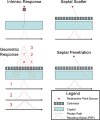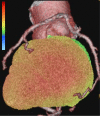Recent Advances in Nuclear Cardiology
- PMID: 27540423
- PMCID: PMC4977260
- DOI: 10.1007/s13139-016-0433-x
Recent Advances in Nuclear Cardiology
Abstract
Nuclear cardiology is one of the major fields of nuclear medicine practice. Myocardial perfusion studies using single-photon emission computed tomography (SPECT) have played a crucial role in the management of coronary artery diseases. Positron emission tomography (PET) has also been considered an important tool for the assessment of myocardial viability and perfusion. However, the recent development of computed tomography (CT)/magnetic resonance imaging (MRI) technologies and growing concerns about the radiation exposure of patients remain serious challenges for nuclear cardiology. In response to these challenges, remarkable achievements and improvements are currently in progress in the field of myocardial perfusion imaging regarding the applicable software and hardware. Additionally, myocardial perfusion positron emission tomography (PET) is receiving increasing attention owing to its unique capability of absolute myocardial blood flow estimation. An F-18-labeled perfusion agent for PET is under clinical trial with promising interim results. The applications of F-18 fluorodeoxyglucose (FDG) and F-18 sodium fluoride (NaF) to cardiovascular diseases have revealed details on the basic pathophysiology of ischemic heart diseases. PET/MRI seems to be particularly promising for nuclear cardiology in the future. Restrictive diseases, such as cardiac sarcoidosis and amyloidosis, are effectively evaluated using a variety of nuclear imaging tools. Considering these advances, the current challenges of nuclear cardiology will become opportunities if more collaborative efforts are devoted to this exciting field of nuclear medicine.
Keywords: Cardiology; Computed tomography; Myocardial infarction; Perfusion; Positron emission tomography; Single-photon emission computed tomography.
Figures







Similar articles
-
Journey in evolution of nuclear cardiology: will there be another quantum leap with the F-18-labeled myocardial perfusion tracers?JACC Cardiovasc Imaging. 2012 Dec;5(12):1269-84. doi: 10.1016/j.jcmg.2012.10.006. JACC Cardiovasc Imaging. 2012. PMID: 23236979
-
[The role of advanced cardiac imaging methods in coronary artery disease].Anadolu Kardiyol Derg. 2008 Jul;8 Suppl 1:1-4. Anadolu Kardiyol Derg. 2008. PMID: 18611832 Review. Turkish.
-
Recent advances in nuclear cardiology.Panminerva Med. 2008 Jun;50(2):105-18. Panminerva Med. 2008. PMID: 18607334 Review.
-
Recent paradigm shifts in molecular cardiac imaging-Establishing precision cardiology through novel 18F-labeled PET radiotracers.Trends Cardiovasc Med. 2020 Jan;30(1):11-19. doi: 10.1016/j.tcm.2019.02.007. Epub 2019 Feb 20. Trends Cardiovasc Med. 2020. PMID: 30824163 Review.
-
[Progress in nuclear cardiology: new imaging beyond perfusion and function].Nihon Igaku Hoshasen Gakkai Zasshi. 1999 Oct;59(12):656-62. Nihon Igaku Hoshasen Gakkai Zasshi. 1999. PMID: 10565167 Review. Japanese.
Cited by
-
Nuclear Cardiology in the Era of Precision Medicine: Tailoring Treatment to the Individual Patient.Cureus. 2024 Apr 24;16(4):e58960. doi: 10.7759/cureus.58960. eCollection 2024 Apr. Cureus. 2024. PMID: 38800181 Free PMC article. Review.
-
The Utility of Nuclear Imaging in Hypertrophic Cardiomyopathy: A Narrative Review.J Clin Med. 2025 Mar 22;14(7):2183. doi: 10.3390/jcm14072183. J Clin Med. 2025. PMID: 40217634 Free PMC article. Review.
-
Update of Takotsubo cardiomyopathy: Present experience and outlook for the future.Int J Cardiol Heart Vasc. 2022 Mar 7;39:100990. doi: 10.1016/j.ijcha.2022.100990. eCollection 2022 Apr. Int J Cardiol Heart Vasc. 2022. PMID: 35281752 Free PMC article. Review.
-
Technetium-99m Radiopharmaceuticals for Ideal Myocardial Perfusion Imaging: Lost and Found Opportunities.Molecules. 2022 Feb 10;27(4):1188. doi: 10.3390/molecules27041188. Molecules. 2022. PMID: 35208982 Free PMC article. Review.
-
Application of animal and human PET in cardiac research.Am J Cardiovasc Dis. 2018 Jun 15;8(3):24-30. eCollection 2018. Am J Cardiovasc Dis. 2018. PMID: 30038843 Free PMC article. Review.
References
-
- Beanlands RS, Nichol G, Huszti E, Humen D, Racine N, Freeman M, et al. F-18-fluorodeoxyglucose positron emission tomography imaging-assisted management of patients with severe left ventricular dysfunction and suspected coronary disease: a randomized, controlled trial (PARR-2) J Am Coll Cardiol. 2007;50:2002–2012. doi: 10.1016/j.jacc.2007.09.006. - DOI - PubMed
-
- Hendel RC, Berman DS, Di Carli MF, Heidenreich PA, Henkin RE, Pellikka PA, et al. ACCF/ASNC/ACR/AHA/ASE/SCCT/SCMR/SNM 2009 Appropriate Use Criteria for Cardiac Radionuclide Imaging: A Report of the American College of Cardiology Foundation Appropriate Use Criteria Task Force, the American Society of Nuclear Cardiology, the American College of Radiology, the American Heart Association, the American Society of Echocardiography, the Society of Cardiovascular Computed Tomography, the Society for Cardiovascular Magnetic Resonance, and the Society of Nuclear Medicine. J Am Coll Cardiol. 2009;53:2201–2229. doi: 10.1016/j.jacc.2009.02.013. - DOI - PubMed
Publication types
LinkOut - more resources
Full Text Sources
Other Literature Sources
